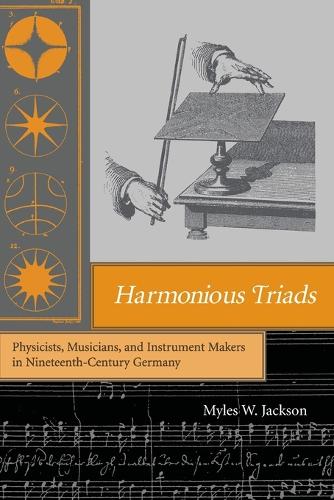
Harmonious Triads: Physicists, Musicians, and Instrument Makers in Nineteenth-Century Germany
(Paperback)
Publishing Details
Harmonious Triads: Physicists, Musicians, and Instrument Makers in Nineteenth-Century Germany
By (Author) Myles W. Jackson
MIT Press Ltd
MIT Press
29th August 2008
United States
Classifications
Professional and Scholarly
Non Fiction
Musical instruments
784.194309034
Physical Properties
Paperback
408
Width 152mm, Height 229mm, Spine 17mm
658g
Description
Historically, music was long classified as both art and science. Aspects of music-from the mathematics of tuning to the music of the celestial spheres-were primarily studied as science until the seventeenth century. In the nineteenth century, although scientists were less interested in the music of the spheres than the natural philosophers of earlier centuries, they remained committed to understanding the world of performing musicians and their instruments. In Harmonious Triads, Myles Jackson analyzes the relationship of physicists, musicians, and instrument makers in nineteenth-century Germany. Musical instruments provided physicists with experimental systems, and physicists' research led directly to improvements in musical-instrument manufacture and assisted musicians in their performances. Music also provided scientists with a cultural resource, which forged acquaintances and future collaborations. Jackson discusses experiments in acoustical vibrations that led to the invention of musical instruments and describes work with adiabatic phenomena that resulted in the improvement of the reed pipe, used by organ builders. He examines the collaborations of physicists and mechanicians aimed at standardizing beat and pitch and considers debates stirred by the standardization of aesthetic qualities. He describes the importance for scientists of choral societies as a vehicle for social life and cultural unity. Finally, he discusses a subject that occupied both physicists and musicians of the era- Could physicists, using the universal principles of mechanics, explain musical skill Was the virtuosity of a Paganini or a Liszt somehow quantifiable Jackson's historical consideration of questions at the intersection of music and physics shows us how each discipline helped shape the other.
Reviews
In this ambitious, demanding, and fascinating book, Myles Jackson examines the intersections of three ostensibly independent communities and shows the several ways in which they helped shape each other.
Technology and CultureAuthor Bio
Myles W. Jackson is Albert Gallatin Research Excellence Professor of the History of Science, NYU-Gallatin;Professor of History, Department of History, NYU-FAS; Director of Science and Society, NYU-CAS; Professor of the Division of Medical Ethics, NYU-Langone School of Medicine; and Faculty Affiliate of the Engelberg Center on Innovation Law and Policy at the New York University School of Law. He is the author of Spectrum of Belief- Joseph von Fraunhofer and the Craft of Precision Optics and Harmonious Triads- Physicists, Musicians, and Instrument Makers in Nineteenth-Century Germany, both published by the MIT Press.
